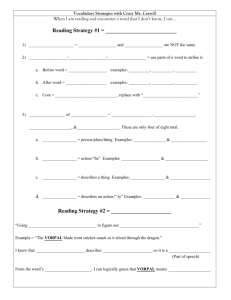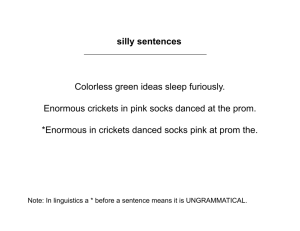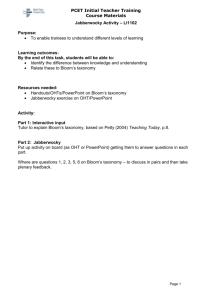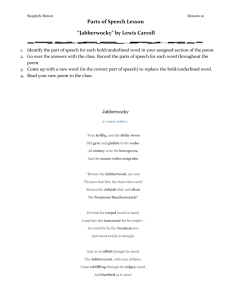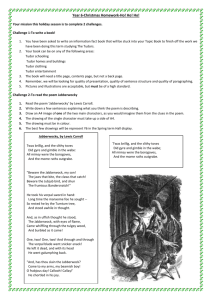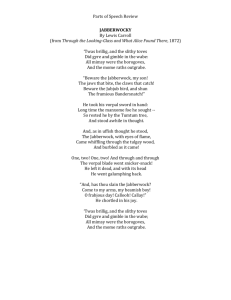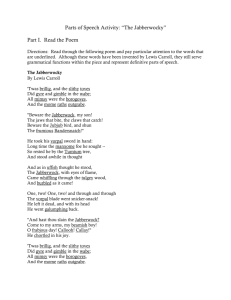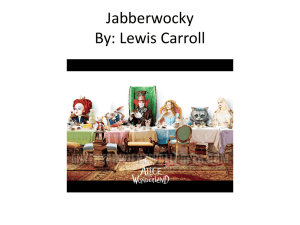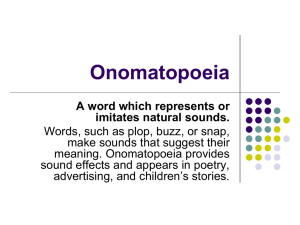The Origin of the poem Jabberwocky
advertisement
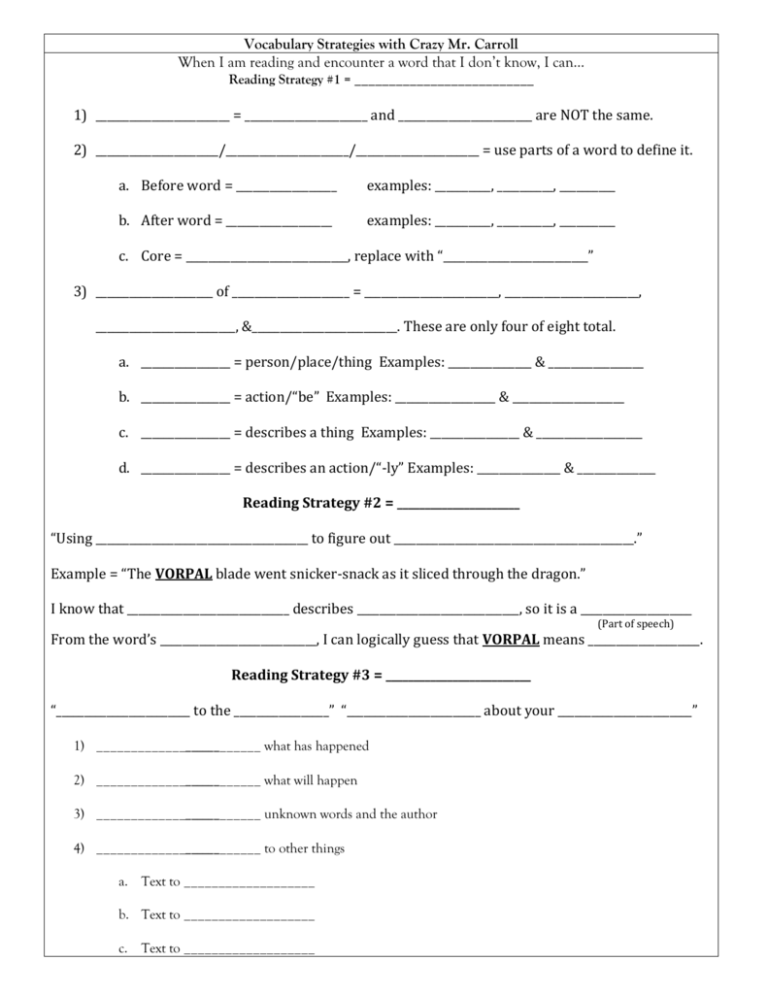
Vocabulary Strategies with Crazy Mr. Carroll When I am reading and encounter a word that I don’t know, I can… Reading Strategy #1 = __________________________ 1) ________________________ = ______________________ and ________________________ are NOT the same. 2) ______________________/______________________/______________________ = use parts of a word to define it. a. Before word = __________________ examples: __________, __________, __________ b. After word = ___________________ examples: __________, __________, __________ c. Core = _____________________________, replace with “__________________________” 3) _____________________ of _____________________ = ________________________, ________________________, _________________________, &__________________________. These are only four of eight total. a. ________________ = person/place/thing Examples: _______________ & _________________ b. ________________ = action/“be” Examples: __________________ & ____________________ c. ________________ = describes a thing Examples: ________________ & ___________________ d. ________________ = describes an action/“-ly” Examples: _______________ & ______________ Reading Strategy #2 = ______________________ “Using ______________________________________ to figure out ___________________________________________.” Example = “The VORPAL blade went snicker-snack as it sliced through the dragon.” I know that _____________________________ describes _____________________________, so it is a ____________________ (Part of speech) From the word’s ____________________________, I can logically guess that VORPAL means ____________________. Reading Strategy #3 = __________________________ “________________________ to the _________________” “________________________ about your ________________________” 1) _________________________ what has happened 2) _________________________ what will happen 3) _________________________ unknown words and the author 4) _________________________ to other things a. Text to ___________________ b. Text to ___________________ c. Text to ___________________ Now lets practice with “Jabberwocky” which was written by Lewis Carroll (author of Alice in Wonderland) in 1871. As you read, record how you use some of the specific vocabulary/reading strategies from above to guess/infer/predict/figure out Carroll’s poem. “Jabberwocky” By Lewis Carroll `Twas brillig, and the slithy toves Did gyre and gimble in the wabe; All mimsy were the borogoves, And the mome raths outgrabe. `Beware the Jabberwock, my son! The jaws that bite, the claws that catch! Beware the Jubjub bird, and shun The frumious Bandersnatch!' He took his vorpal sword in hand: Long time the manxome foe he sought – So rested he by the Tumtum tree, And stood awhile in thought. And as in uffish thought he stood, The Jabberwock, with eyes of flame, Came whiffling through the tulgey wood, And burbled as it came! One, two! One, two! And through and through The vorpal blade went snicker-snack! He left it dead, and with its head He went galumphing back. `And has thou slain the Jabberwock? Come to my arms, my beamish boy! O frabjous day! Callooh! Callay! He chortled in his joy. `Twas brillig, and the slithy toves Did gyre and gimble in the wabe; My metacognitive thoughts All mimsy were the borogoves, And the mome raths outgrabe. Now, using your T4 thoughts and your examples of using the vocabulary strategies, write a 30 word summary of the poem. What literally happened? Use exactly 30 words. Learning Targets 4.0 Comprehend and explain the literal main ideas & details & cite text evidence I can insightfully explain author’s meaning by citing text evidence Build vocabulary by determining meanings of unknown words by using context, word parts & parts of speech. I can accurately master unfamiliar words accurately & incorporate these words into my own writing seamlessly beyond teacher’s expectations. accurately beyond teacher’s expectations. 3.0 2.0 1.0 I can plainly explain the author’s meaning by citing text evidence relatively accurately & consistently. I can just mention the author’s meaning by citing text evidence somewhat accurately and I struggle to identify the author’s meaning by citing text evidence. I have some inaccuracies somewhat consistently. and/or need teacher assistance. I can accurately learn I can partially learn I struggle to personalize unfamiliar words unfamiliar words somewhat unfamiliar words and/or consistently & incorporate these consistently & inconsistently. incorporate these words into words into my own I incorporate these words my own writing. I need writing plainly and into my own writing. teacher help regularly. to do this proficiently. Here are the links to the movie clips I found, Mr. Foster. I apologize for e-mailing you so late as well, but I had a few things to take care of before I got onto my computer. This one is the Monty Python version. Its very entertaining but it doesn’t end the same way the poem does. https:youtube.com/watch?v=9GxgnAeg-uU//www This next clip is a movie trailer, and not really a part of a movie, but I thought that it would be possible to find meanings to most of the words within it. https://www.youtube.com/watch?v=IuKvWYIZoUE “Jabberwocky” http://www.math.luc.edu/~vande/jabberwocky.html There are two main sources to assist one in understanding the poem. One is Lewis Carroll himself. In one of a series of private little "periodicals" that young Carroll wrote, illustrated and hand-lettered for the amusement of his siblings, he described a "curious fragment". After a drawing of it, he proceeded to interpret some of the words. These explanations are listed below. The other source of explanations comes from Humpty Dumpty, whom Alice meets in Chapter VI of the book. He also provides explanations of some of the words -- not always the same as Carroll. These too are listed below. Word Carroll's Explanation Humpty Dumpty's Explanation Bryllyg (derived from the verb to bryl or Four o'clock in the afternoon -- the time brillig broil). The time of broiling dinner, i.e., when you begin broiling things for dinner. the close of the afternoon. Lithe and slimy. Lithe is the same as 'active.' Slythy (compounded of slimy and lithe). ... It's like a portmanteau -- there are two slithy Smooth and active. meanings packed up into one word. tove Tove, a species of badger. They had smooth white hair, long hind legs, and short horns like a stag; lived chiefly on cheese. "Toves" should be pronounced to rhyme with "groves". Something like badgers -- they're something like lizards -- and they are something like corkscrews. ... They make their nests under sundials -- also they live on cheese. gyre Gyre, verb (derived from gyaour or giaour, 'a dog'). To scratch like a dog. To go round and round like a gyroscope. gimble wabe mimsy Gymble (whence gimblet). To screw out To make holes like a gimlet. holes in anything. The grass plot round a sundial ... because it Wabe (derived from the verb to swab or goes a long way before it, and a long way soak). The side of a hill (from its being behind it ... and a long way beyond it on each side. (Humpty Dumpty's explanation soaked by the rain.) was made with some "insights" from Alice.) Mimsy (whence mimserable and miserable.) Unhappy. Flimsy and miserable. Borogove. An extinct kind of parrot. They had A thin shabby-looking bird with its feathers sticking borogoves no wings, beaks turned up, and made their out all round -- something like a live mop. nests under sundails; lived on veal. The first 'o' in 'borogoves' is pronounced like the 'o' in 'worry'. The word is commonly mispronounced as "borogroves" ... and this misspelling even appears in some American editions of the book. mome I'm not certain about mome. I think it's short for 'from home' -- meaning that they'd lost their way. raths A rath is a sort of green pig. outgrabe Outgribing is something between bellowing and whistling, with a kind of sneeze in the middle. The Origin of the poem Jabberwocky The opening stanza of Jabberwocky first appeared in Misch-Masch which was the last of a series of private little "periodicals" which the young Lewis Carroll wrote, illustrated, and hand-lettered for the amusement of his brothers and sisters. In an issue dated 1855 (he was then 23), under the heading "Stanza of Anglo-Saxon Poetry," the following "curious fragment" appears: Carroll then proceeded to interpret the words of the fragment. These interpretations or explanations are listed in the glossary. When he had finished giving the various explanations, he then wrote: Hence the literal English of the passage is: 'It was evening, and the smooth active badgers were scratching and boring holes in the hill-side; all unhappy were the parrots; and the grave turtles squeaked out.' There were probably sundials on the top of the hill, and the 'borogoves' were afraid that their nests would be undermined. The hill was probably full of the nests of 'raths', which ran out, squeaking with fear, on hearing the 'toves' scratching outside. This is an obscure, but yet deeply-affecting, relic of ancient Poetry. It is interested to look at the glossary and compare these explanations with those given by Humpty Dumpty. One can also notice that in the final version of the poem, a few of the words are spelled differently: bryllyg becomes brillig, for example.
